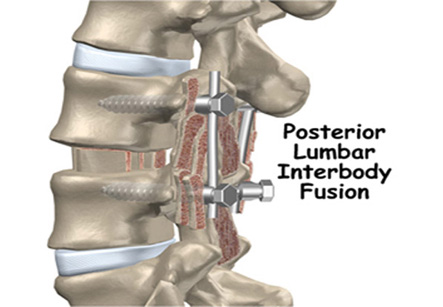Spinal Fusion Surgery
Introduction
Spinal fusion surgery essentially involves fusion or joining of two or more vertebrae of the back. It is usually a complicated surgery that is undertaken among patients with severe back pain and severely restricted movement due to back pain or other back pathologies.
Spinal fusion may be of different types but the basic principle of joining two vertebrae with the help of new bone growth and with the help of metal prosthetics remains the same. The surgery may last several hours. It may be accompanied by other surgical techniques to correct spinal problems.
Surgical Technique
This surgery is usually performed under general anesthesia where the patient is rendered unconscious. Alternatively epidural anesthesia to render the back and lower limbs numb while remaining conscious may also be practiced in some patients. As a first step the area over the hip bone is cleansed and sterilized. An incision is made over the hip bone to reach up to the bone. The donor bone chip is taken from the hip bone. This bone chip would eventually hold the vertebrae together. After retrieval of the donor graft from the patient the incision is closed with stitches and dressed.
We have all the information you need about public and private clinics and hospitals that provide spinal surgery in Iran, Islamic Republic Of with the best quality and lowest possible prices

Spinal fusion may also be clubbed with other procedures like removal of painful bone growths, easing spinal compression…
Now the donor graft bone is used to make a bridge between the vertebrae. The patient is made to lie on his/her chest and the affected area of the back is cut open. The gathered bone chip is now placed over the vertebral joint as a bridge. This bone chip will grow into bone and will join the two vertebrae naturally. In order to reinforce the bridge specially made metal implants are placed over the bridge.
Spinal fusion may also be clubbed with other procedures like removal of painful bone growths or easing spinal compression. This procedure may also be used to look at the health of other vertebrae for infections, tumors or herniated discs or disc prolapse that can be corrected in one or more settings.
Post operative considerations and recovery
After the operation the skin and tissues of the back are stitched up or stapled and the back is dressed. The patient may need to stay in the hospital for the initial few days of recovery. There may be initial pain and stiffness.
Once released from the hospital complete bed rest may not be recommended. However a back brace is advised to maintain the posture of the back. As is obvious heavy work, lifting weights etc. are not allowed before the patient is completely healed. However other activities like walking, swimming, riding a stationary bike etc. may be allowed gradually to relieve the back stiffness.
This surgery does not guarantee complete recovery of back function and complete relief of pain. The risks and benefits of surgery need to be discussed before hand. Common complications include pain, failure of the fusion, breakage of bone graft or metal implants, bleeding, infections, nerve damage, blood clots going up to the brain or lungs leading to life threatening complications.